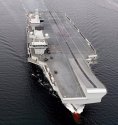The technology glitches plaguing the
, lead ship of the Navy’s next generation of flattops, are getting fixed, officials told lawmakers during a Tuesday hearing on Capitol Hill.
The combination punch of good news at the Senate Armed Services' Seapower Subcommittee included testimony that the Navy has recorded significant cost savings during the building of the John F. Kennedy, the next Ford-class carrier, and is prepping to purchase two similar flattops in fiscal 2020.
Pressed by Sen. Tim Kaine, D-Virignia, on possible problems with the Ford’s advanced weapons elevators,
—assistant secretary of the Navy for research, development and acquisition — predicted the Ford would leave the
with a working system for delivering ordnance to the flight deck.
“I would say of all of the technologies on the CVN 78, of which there were many we proved out on this lead ship, the weapons elevator is the last one that we need to get tied up and work our way through,” Geurts said. “We are making progress to get through all the elevators during this availability.”
The Ford has 11 weapons elevators and each must be build, tested and certified separately, Geurts explained.
“The first two of them have been produced - the first one has been through test and certification and the second one is about 94 percent through testing,” he said.
Pushed harder by Kaine on whether they would be fully operational, Geurts said the “current assessment is we’ll get through all of the production and much of the testing” but might face some lingering “certification issues." He pledged to monitor the process “very closely.”
The Ford has
to President Donald J. Trump, who repeatedly bashes the carrier’s Electromagnetic Aircraft Launch System, or EMALS, which is replacing traditional steam-powered catapults.
In a Thanksgiving call to Capt. Pat Hannifin, the commanding officer of the Nimitz-class carrier Ronald Reagan while it was visiting Hong Kong, Trump
.
“Tell me about the catapult,” Trump said. “On Gerald Ford, they don’t use steam, which is the first one that I’ve ever heard of that doesn’t use steam. And I know they have some difficulties, which I’m not happy about, and they spent a lot of money. And I was just curious — the steam system is tried and true for many, many years, as long as we’ve had aircraft carriers, how do you find steam versus what they’re doing on the Gerald Ford, which is electronic and digital, if you can believe it.”
Hannifin told Trump that while the Nimitz class of carriers has depended on the reliable steam catapults for generations, EMALS “offered some great benefits” such as reducing stress on aircraft, but like any new system it required experts to “work through the bugs.”
Unlike legacy steam catapults, EMALS was designed to vary the stroke of the launch based on the size and weight of the aircraft its hurling into the air. That’s particularly important for launching relatively light aircraft like aerial drones.
Initial software gremlins prevented the Ford from deploying combat-loaded aircraft but Navy officials believe a system update slated to be installed while the carrier is in the shipyard will fix them.
Echoing Trump on Tuesday, subcommittee chairman Sen. Roger Wicker, R-Mississippi, grilled Geurts on whether Congress will “be glad we with the EMALS and Advanced Arresting Gear?”
Noting
, plus more than 24,000 launch and recovery cycles using the systems at the land-based site in , Geurts was optimistic.
“While there have been technical difficulties we’ve had to work through, it really opens up our ability to operate a wider variety of aircraft from the deck, both manned and unmanned which I think is going to be critical to those effective carrier operations as we look to the future,” Geurts said.
Geurts also said there was “good progress” on the Ford’s
, without "any major technical issues.”
A leader of the Virginia delegation, Kaine was keen on whether the Navy will bundle a two-carrier deal for the future Enterprise and the unnamed CVN-81.
“We are, as you know, in the ’20 budget process right now so we have not made a final decision on that buy,” Geurts said. “I would expect that decision by sometime by the end of this calendar year.”
The Navy is negotiating with
to deliver the best price for taxpayers and Geurts said he wanted to forge an order over the next month because “if it were pushed out much further, the savings achievable would start to erode.”
“We think those savings will be better than the $2.5 billion number that I quoted at the last time we spoke,” he told lawmakers.
Despite the initial problems with the Ford, Geurts said that the lessons learned have added up to significant savings in time and money on the next carrier in the class, the
, including so far shaving 16 percent off the new flattop’s production labor hours.
“As we look towards CVN-79, we’re seeing fairly drastic reduction in labor hours,” Geurts said. “[Huntington Ingalls] has proven that once we get the design nailed down their ability to be efficient in producing those."






